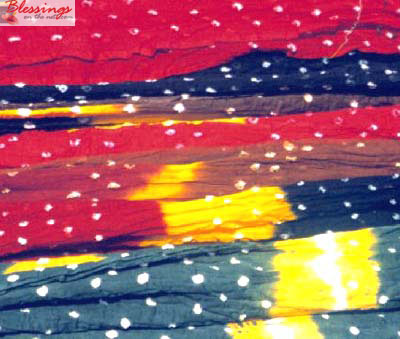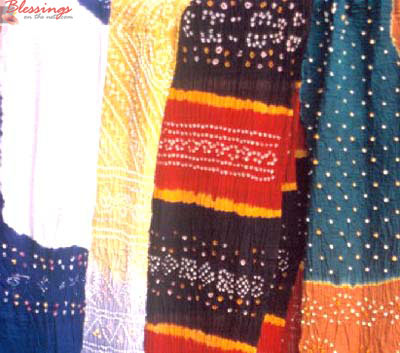Patolas are usually easily among the best Ikat sarees and are from Gujarat. There is a family in Gujarat whose sarees retailed for US$2000 in the early '80s - this family weaves one saree a year and I am honored to have even seen such a piece. Of course at that time, as a teenager I thought everything about this was just hype and altogether ridiculous !
About Bandhini - 'Bandh' basically means to tie or 'secure' something.
First Bandhini is associated with two states - the eastern states of Orissa and the western staes of Gujarat & Raasthan. How such a technique was adopted by opposite ends of the country I have no idea. One possibility is that both these areas have several 'tribes' . If these were migratory tribes, then we might have an explanation.
The Bandhini from Gujarat is a very different type. Here the fabric is created completely first. Then the design and colours are planned out. Lets say we would like a yellow flower against a red background. The design of the flower would then be tied up using resitant thread to cover up the area of the flower. If this is to be repeated across the fabric, then it is first folded so that the necessary pattern is easily replicated in the places required. Spatially challenged people like me would probably fold it wrongly and never get mirror symmetries and rotations as required !
The fabric all tied up in several parts and looking like a crumpled piece of fabric with lots of moutains and valleys is then dyed in the red. Once it is fixed, the knots are opened up to expose the parts of the fabric which lay below the thread - the flower. the process is then repeated for the next dye. While this is easy for small elements, I am not very clear about how large parts would be 'covered up' .


The process followed at the other end of the country is entirely different and may not be related at all inspite of all the adventurous conjectures on my part regarding migrating tribes.

In the case of the double ikat of Orissa, both warp & weft are dyed using the following process. First the threads are arranged onto the loom and the design is planned out. Once again, lets say we want a white flower against a purple ground. First the parts of the threads that will later be the white flower, are all taped up. This is prior to dyeing. The entire set of taped up unwoven threads are taken off the loom and dyed purple with the 'flower' portions undyed and protected by the tape. The tape is then removed and reveals the white patches at different lengths of the thread - the first at 2 cm , the next at 2.1 cm and so on . These threads are now ready for weaving. This process is followed separately for the warp and the weft. And in the final stage they are woven in.
I assume this must be infinitely more complex as there is very little flexibililty left now. Imagine that you have 1000 threads now all the wefts, each preordered so as to produce a flower. and another 1000 warps also preordered to complete the flower !!
Any mix up could drive an unmeticulous weaver totally crazy. Or produce some surrealistic designs !! Am I glad that all I have to do is wear these beautiful things and gaze at them lovingly form time to time. No weaving of this sort for me !
And a similar technique is also used in Indonesia where it is also known as Ikat. Indonesia shares much of the Indian culture - even elements of the epics Ramayana are very very active and alive in the culture. ('Bali' the tropical paradise is a character from the Ramayana).
All of this is my understanding of the subject and I hope but do not guarantee that I am correct ......

Cheers
Jaina Mishra